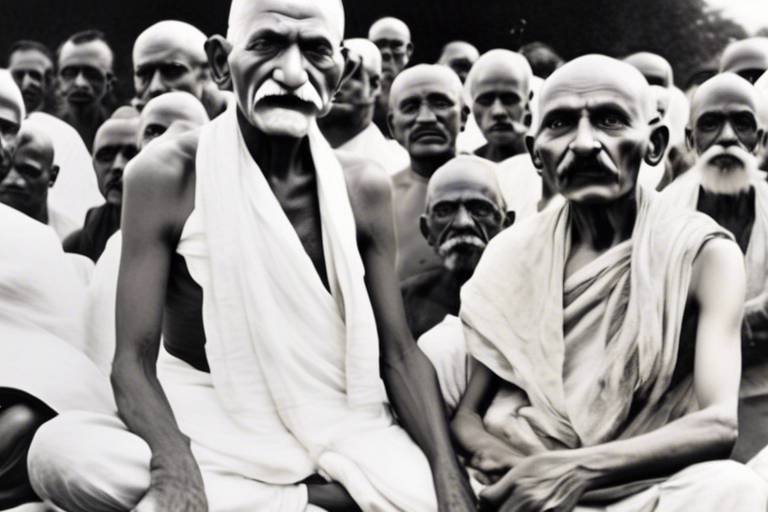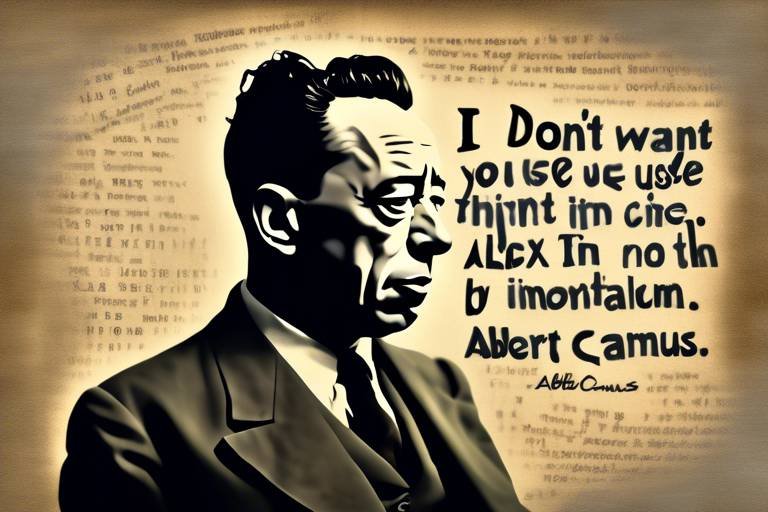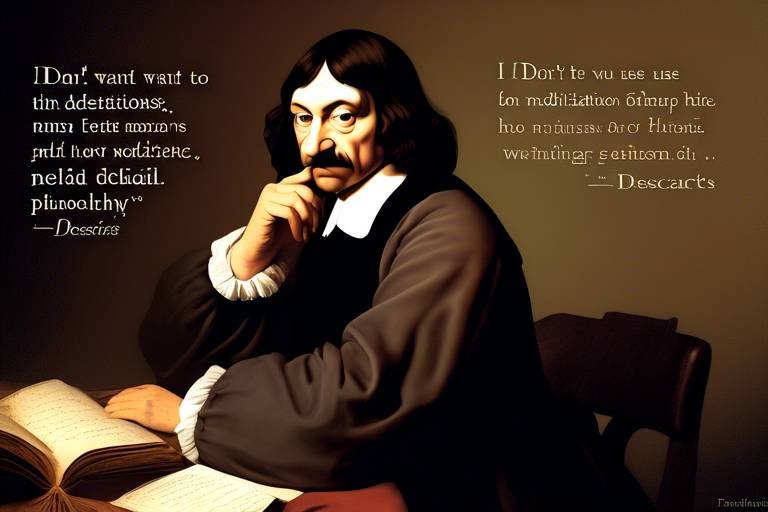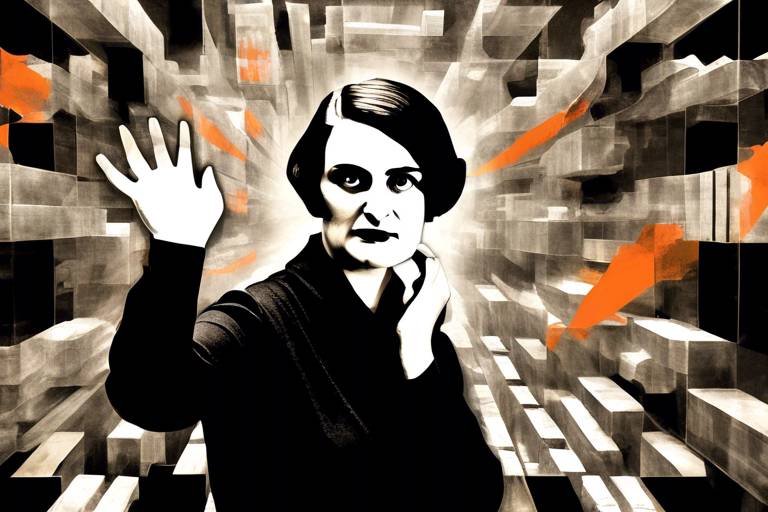The Philosophy of Gandhi - Satyagraha and Non-Violence
The philosophy of Mahatma Gandhi, particularly his concepts of Satyagraha and non-violence, has left an indelible mark on the world. These principles not only served as tools for India's struggle against British colonial rule but also paved the way for countless movements for justice and equality across the globe. Gandhi's approach is a testament to the power of peaceful resistance and the profound impact of truth as a guiding force in the quest for social change. But what exactly do these concepts entail, and how can they be applied in our modern world?
Satyagraha, a term coined by Gandhi, encapsulates the idea of truth force or the force of truth. It is rooted in the belief that the pursuit of truth is inherently linked to the struggle against injustice. The origins of Satyagraha can be traced back to Gandhi's experiences in South Africa, where he first confronted racial discrimination. It is more than just a method of protest; it is a way of life that emphasizes the importance of love, compassion, and the moral imperative to resist oppression without resorting to violence.
At its core, Satyagraha is about standing firm in one's truth while also respecting the humanity of the opponent. This principle challenges us to consider the nature of our struggles. Are we fighting against people, or are we fighting against injustice? Gandhi believed that by focusing on the latter, we could create a more just and peaceful society. This philosophical framework serves as a powerful reminder that change is possible, even in the face of overwhelming odds.
Non-violence, or Ahimsa, is another cornerstone of Gandhi's philosophy. It is not merely the absence of violence; rather, it is an active force for good that promotes understanding and compassion. Gandhi argued that non-violence is the most potent weapon available to oppressed people. This principle extends beyond political activism and into personal conduct, urging individuals to cultivate peace within themselves and in their interactions with others.
The ethical implications of non-violence are profound. It challenges individuals to reflect on their behaviors and attitudes, fostering a culture of empathy and understanding. Practically, non-violence requires immense courage and discipline. It is easy to resort to anger or aggression when faced with injustice, but Gandhi's teachings remind us that true strength lies in restraint and compassion. By embracing non-violence, we not only transform our own lives but also inspire others to join the quest for justice.
To fully appreciate the depth of Gandhi's philosophy, we must consider the historical context in which he operated. The early 20th century was marked by British colonial rule in India, a time characterized by oppression, inequality, and widespread suffering. Gandhi emerged as a leader who not only recognized the dire need for change but also understood that the means of achieving that change were just as important as the end goal.
His philosophy of Satyagraha and non-violence was a direct response to the brutality of colonialism. Gandhi believed that the struggle for independence could not be achieved through violence, as violence breeds more violence. Instead, he advocated for a peaceful resistance that would galvanize the masses and unite them in a common cause. This approach not only challenged the colonial authorities but also empowered ordinary people to take part in the fight for their rights.
Gandhi's philosophy was shaped by various influences, including Hinduism, Christianity, and Jainism. These traditions emphasized the importance of truth, compassion, and non-violence, which resonated deeply with Gandhi. For instance, the concept of Ahimsa in Jainism profoundly influenced his commitment to non-violence. Similarly, the teachings of Jesus Christ about love and forgiveness inspired him to advocate for peaceful resistance.
By synthesizing these diverse influences, Gandhi crafted a unique philosophy that transcended cultural and religious boundaries. His teachings continue to inspire individuals and movements around the world, demonstrating the universal appeal of his message.
Before gaining prominence in India, Gandhi practiced Satyagraha in South Africa, where he faced racial discrimination firsthand. His early experiments with this philosophy included organizing protests against unjust laws, such as the requirement for Indians to carry passbooks. These experiences taught him valuable lessons about the power of collective action and the importance of maintaining moral integrity in the face of adversity.
Through these initial struggles, Gandhi refined his methods and developed a deeper understanding of Satyagraha. He learned that the effectiveness of non-violent resistance lies not only in the actions taken but also in the spirit of the movement. By embodying the principles of love and truth, he was able to mobilize communities and create lasting change.
Gandhi's application of Satyagraha in India is perhaps best exemplified by the Salt March in 1930 and the Quit India Movement in 1942. The Salt March was a pivotal moment in the Indian independence movement, where Gandhi led thousands of people on a 240-mile march to the Arabian Sea to protest the British salt tax. This act of civil disobedience captured the imagination of the nation and highlighted the power of non-violent resistance.
Similarly, the Quit India Movement called for an end to British rule in India. Gandhi's call for mass non-violent resistance galvanized millions of Indians to join the struggle for independence. Through these movements, he demonstrated the effectiveness of Satyagraha in challenging colonial authority and inspiring a nation to rise against oppression.
Gandhi's teachings on Satyagraha and non-violence have transcended borders, influencing numerous global movements for justice and equality. Leaders such as Martin Luther King Jr. and Nelson Mandela drew inspiration from Gandhi's principles in their own struggles for civil rights and freedom. The resonance of his philosophy can be seen in contemporary movements advocating for social justice, environmental sustainability, and human rights.
Today, Gandhi's principles of non-violence continue to resonate in various movements around the world. From the civil rights movement in the United States to the environmental activism led by figures like Greta Thunberg, the spirit of non-violence remains a powerful force for change. These contemporary movements embody Gandhi's teachings, demonstrating that peaceful resistance can lead to significant social transformation.
While Gandhi's philosophy has been widely celebrated, it has also faced criticism. Some argue that non-violence is not always a feasible or effective response to oppression, particularly in today's complex socio-political landscape. Critics point to instances where violent resistance has led to rapid change, questioning the applicability of Gandhi's principles in certain contexts.
However, despite these critiques, Gandhi's teachings remain relevant. They challenge us to consider the moral implications of our actions and the importance of empathy in the face of conflict. Ultimately, the philosophy of Satyagraha and non-violence invites us to envision a world where justice is pursued through love and understanding, rather than hatred and violence.
- What is Satyagraha? Satyagraha is a philosophy of non-violent resistance developed by Gandhi, emphasizing the power of truth and moral integrity in the struggle against injustice.
- How did Gandhi's philosophy influence global movements? Gandhi's teachings inspired leaders and activists worldwide, promoting non-violence as an effective means of social change.
- What are the main principles of non-violence? The main principles include compassion, empathy, and the commitment to resist oppression without resorting to violence.
- Can non-violence be effective in today's world? While challenges exist, many contemporary movements demonstrate that non-violence remains a powerful tool for achieving social justice.
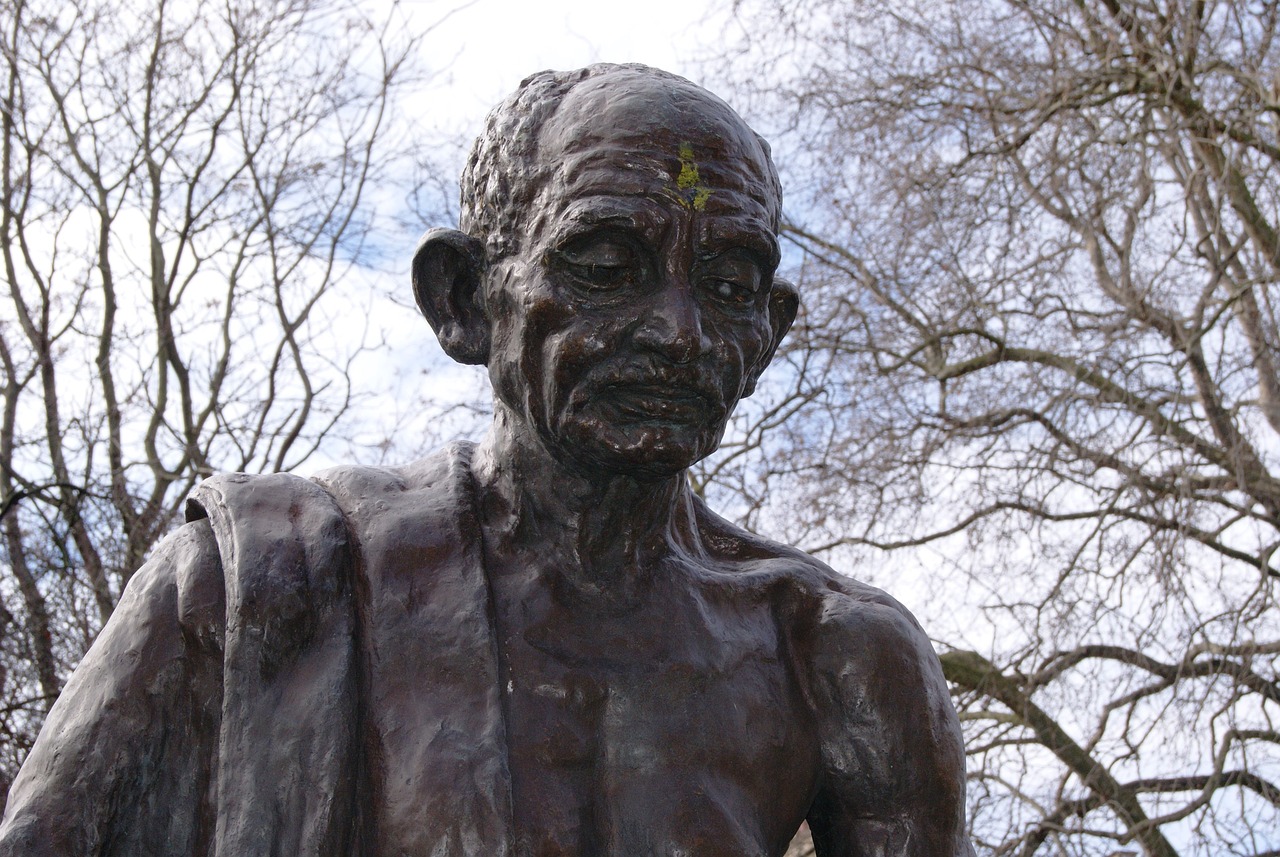
Understanding Satyagraha
Satyagraha, a term that resonates deeply with the essence of Gandhi's philosophy, is often translated as "truth force" or "soul force." But what does this really mean? At its core, Satyagraha is about the power of truth and the steadfastness of the human spirit in the face of oppression. Gandhi believed that by adhering to truth and non-violence, individuals could not only resist tyranny but also transform the hearts of their oppressors. This approach is rooted in the belief that truth is the ultimate weapon in the struggle for justice.
The origins of Satyagraha can be traced back to Gandhi's experiences in South Africa, where he first faced racial discrimination. It was here that he began to formulate his ideas about non-violent resistance. The significance of Satyagraha extends beyond mere protest; it is a philosophy that encourages individuals to engage in active resistance while maintaining their moral integrity. This idea is beautifully encapsulated in Gandhi's assertion that "an unjust law is no law at all." By refusing to comply with such laws, individuals assert their moral authority and challenge the legitimacy of oppressive systems.
One of the key aspects of Satyagraha is the emphasis on self-discipline and inner strength. Gandhi taught that true strength comes not from physical power or violence, but from the ability to remain peaceful and steadfast in one's convictions. This requires a deep understanding of oneself and a commitment to personal transformation. Satyagraha is not just a method of protest; it is a way of life that encourages individuals to cultivate love, compassion, and understanding, even towards those who oppress them.
Gandhi's Satyagraha is also characterized by its strategic nature. It is not a haphazard approach to resistance but rather a carefully planned and executed strategy that seeks to engage the oppressor in dialogue and understanding. This can involve various forms of non-violent action, including:
- Peaceful protests
- Boycotts of oppressive institutions
- Non-cooperation with unjust laws
- Hunger strikes
Through these actions, Satyagraha aims to create a situation where the oppressor is faced with the moral dilemma of continuing their oppressive actions against peaceful individuals. The ultimate goal is to bring about change not just in laws or policies, but in the hearts and minds of people.
As we delve deeper into the philosophy of Satyagraha, it's essential to recognize its relevance in today's world. In an era marked by conflict and division, Gandhi's teachings remind us that the pursuit of truth and justice can be achieved through peaceful means. Satyagraha encourages us to confront injustice with courage, to seek understanding rather than retaliation, and to believe in the transformative power of love and compassion.
In summary, Satyagraha is more than a method of resistance; it is a profound philosophy that champions the strength of truth and the efficacy of non-violence. By embracing Satyagraha, individuals can become agents of change, not just in their communities but in the broader world. It is a call to action that challenges us to rise above our circumstances and strive for a more just and equitable society.

truth force.
This article explores the core principles of Gandhi's philosophy, focusing on Satyagraha and non-violence as powerful tools for social change and personal transformation in the face of oppression.
Satyagraha, a term coined by Gandhi, embodies the concept of truth force. This section delves into its origins, meaning, and significance in the struggle for justice and equality.
The term "Satyagraha" is derived from two Sanskrit words: "Satya," meaning truth, and "Agraha," meaning firmness or insistence. Together, they signify a steadfast adherence to truth, a principle that Gandhi believed could be a formidable weapon against oppression. Imagine standing firm like a mountain, unyielding against the winds of injustice. This is the essence of Satyagraha. It is not merely passive resistance; it is a proactive force that compels change through the power of truth.
Gandhi believed that every individual possesses an inherent truth that, when pursued with sincerity and determination, could lead to profound transformations in society. He often emphasized that Satyagraha is rooted in the idea that truth is the ultimate reality and that it has the power to awaken the conscience of oppressors. In this sense, Satyagraha is both a personal and collective journey toward justice.
Throughout his life, Gandhi demonstrated that the practice of Satyagraha could take many forms, from peaceful protests to hunger strikes, all aimed at highlighting injustice and invoking a sense of moral responsibility among the oppressors. For instance, during the Salt March of 1930, Gandhi and his followers marched over 240 miles to the Arabian Sea to produce salt, defying British laws. This act of civil disobedience was not just a protest against taxation; it was a powerful assertion of their right to live freely and truthfully.
In essence, Satyagraha is about harnessing the power of truth to bring about social change. It encourages individuals to confront injustice not with violence, but with a steadfast commitment to truth. This approach is not only transformative for the individual but also inspires others to join the cause, creating a ripple effect of awareness and action.
Non-violence is a cornerstone of Gandhi's philosophy. Here, we examine the ethical and practical implications of non-violence in both personal conduct and political activism.
Understanding Gandhi's philosophy requires a look at the historical context in which he operated, including British colonial rule and the Indian independence movement.
Gandhi drew inspiration from various sources, including Hinduism, Christianity, and Jainism. This section outlines these influences and how they shaped his views on non-violence and truth.
Before gaining prominence in India, Gandhi practiced Satyagraha in South Africa. This subheading explores his early experiences and the lessons learned that would inform his later activism.
This section discusses how Gandhi applied Satyagraha in various movements, such as the Salt March and Quit India Movement, demonstrating its effectiveness in challenging colonial authority.
Gandhi's teachings on Satyagraha and non-violence have influenced numerous global movements. Here, we explore how his philosophy inspired leaders and activists worldwide.
From civil rights to environmental activism, Gandhi's principles of non-violence continue to resonate. This section highlights contemporary movements that embody his teachings.
While widely celebrated, Gandhi's philosophy has faced criticism. This subheading examines the challenges and limitations of applying non-violence in today's complex socio-political landscape.
- What is Satyagraha?
Satyagraha is a philosophy developed by Gandhi that emphasizes the power of truth and non-violent resistance to bring about social change.
- How does non-violence work in activism?
Non-violence promotes peaceful protests and civil disobedience, aiming to awaken the moral conscience of oppressors without resorting to violence.
- Can Satyagraha be applied today?
Yes, Satyagraha remains relevant today, inspiring movements for social justice, equality, and environmental activism worldwide.
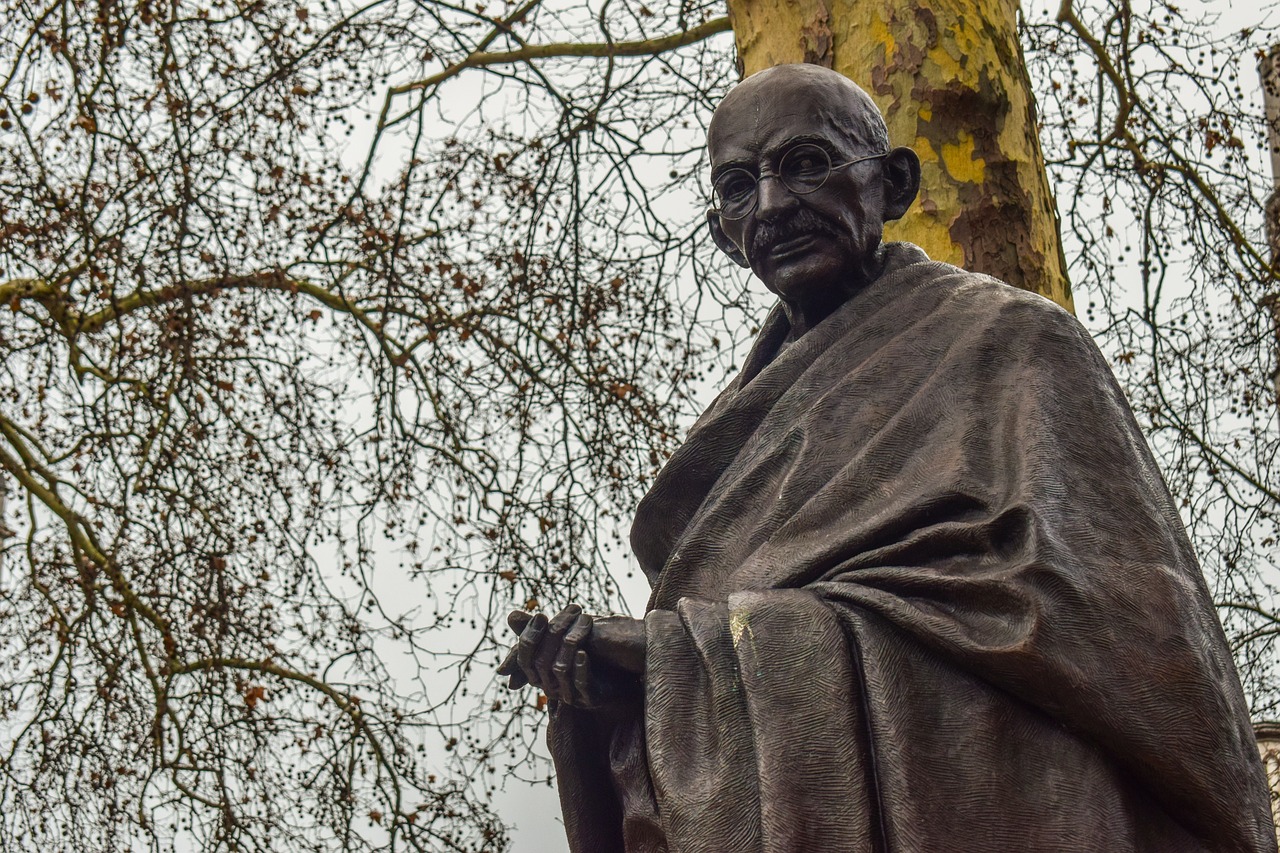
This section delves into its origins, meaning, and significance in the struggle for justice and equality.
Satyagraha, a term coined by Gandhi, embodies the concept of truth force. This powerful notion is not just about passive resistance but is deeply rooted in the belief that truth and justice will ultimately prevail over oppression. The origins of Satyagraha can be traced back to Gandhi's early experiences in South Africa, where he first encountered racial discrimination. It was during this time that he began to formulate his philosophy of non-violent resistance as a means to combat injustice.
At its core, Satyagraha is about the pursuit of truth through non-violent means. Gandhi believed that every individual has an inherent duty to seek the truth and stand against injustice, but this must be done without resorting to violence. This principle is significant in the struggle for justice and equality because it empowers individuals to challenge oppressive systems while maintaining their moral integrity. Rather than inciting violence or hatred, Satyagraha encourages a sense of compassion and understanding, even towards those who oppress.
Moreover, Satyagraha is not merely a political tool; it is a way of life. It requires immense courage, self-discipline, and a commitment to non-violence. Gandhi's approach emphasized the importance of personal transformation alongside social change. By practicing Satyagraha, individuals not only fight against injustice but also cultivate their own moral and spiritual development. This dual focus on personal and social transformation is what makes Satyagraha a profound and enduring philosophy.
In the context of the Indian independence movement, Satyagraha became a rallying cry for millions. It was a powerful response to British colonial rule, showcasing how collective non-violent action could effectively challenge an empire. The significance of Satyagraha lies in its ability to unite people across different backgrounds and beliefs, fostering a sense of solidarity in the face of oppression. This unity was crucial in mobilizing the masses and creating a formidable force against colonial authority.
Ultimately, Satyagraha is a testament to the strength of human spirit and the belief that non-violence can be a powerful catalyst for change. Its legacy continues to inspire movements for justice and equality around the world, proving that the path of peace is not only possible but also profoundly transformative.
Non-violence is a cornerstone of Gandhi's philosophy. Here, we examine the ethical and practical implications of non-violence in both personal conduct and political activism.
Understanding Gandhi's philosophy requires a look at the historical context in which he operated, including British colonial rule and the Indian independence movement.
Gandhi drew inspiration from various sources, including Hinduism, Christianity, and Jainism. This section outlines these influences and how they shaped his views on non-violence and truth.
Before gaining prominence in India, Gandhi practiced Satyagraha in South Africa. This subheading explores his early experiences and the lessons learned that would inform his later activism.
This section discusses how Gandhi applied Satyagraha in various movements, such as the Salt March and Quit India Movement, demonstrating its effectiveness in challenging colonial authority.
Gandhi's teachings on Satyagraha and non-violence have influenced numerous global movements. Here, we explore how his philosophy inspired leaders and activists worldwide.
From civil rights to environmental activism, Gandhi's principles of non-violence continue to resonate. This section highlights contemporary movements that embody his teachings.
While widely celebrated, Gandhi's philosophy has faced criticism. This subheading examines the challenges and limitations of applying non-violence in today's complex socio-political landscape.
- What is Satyagraha? - Satyagraha is a philosophy developed by Gandhi that emphasizes non-violent resistance and the pursuit of truth in the face of injustice.
- How did Gandhi apply Satyagraha in India? - Gandhi used Satyagraha in various movements, including the Salt March and the Quit India Movement, to mobilize people against British colonial rule.
- What is the significance of non-violence? - Non-violence is significant as it promotes peaceful means of protest and encourages moral integrity while challenging oppressive systems.

The Principles of Non-Violence
Non-violence is not just a tactic; it is a profound philosophy that Gandhi championed throughout his life. At its core, non-violence is about more than simply refraining from physical aggression. It embodies a way of living that seeks to promote peace, understanding, and mutual respect. Gandhi believed that true strength lies in the ability to confront injustice without resorting to violence. This principle is beautifully encapsulated in his famous saying, "An eye for an eye only ends up making the whole world blind." In this way, non-violence becomes a powerful tool for social change, urging individuals to rise against oppression while maintaining their moral integrity.
One of the key tenets of non-violence is the idea of ahimsa, which translates to 'non-harming' in Sanskrit. This principle extends beyond physical violence to include verbal and emotional harm. Gandhi emphasized that to truly practice non-violence, one must cultivate love and compassion for all beings. This is not always easy; it requires a deep commitment to self-discipline and the ability to empathize with others, even those who may be causing harm. The journey toward non-violence often begins within, as individuals learn to confront their own biases and anger.
Another essential aspect of non-violence is the concept of satyagraha, which means 'truth force.' Satyagraha is not merely passive resistance; it is an active form of non-violent protest that seeks to bring about change through the power of truth and moral persuasion. Gandhi believed that by adhering to truth, individuals could confront injustice and inspire others to join their cause. This approach encourages a collective awakening to the need for justice while fostering a sense of unity and shared purpose among those involved.
In practice, non-violence can take many forms, including peaceful protests, civil disobedience, and boycotts. For instance, during the Salt March in 1930, Gandhi led thousands of Indians in a non-violent protest against British salt laws. This act of civil disobedience not only challenged colonial authority but also galvanized the Indian population around the cause of independence. The Salt March is a prime example of how non-violence can effectively mobilize communities and create significant social change.
However, the principles of non-violence are not without their challenges. Critics often argue that non-violence can be seen as a sign of weakness or passivity in the face of aggression. Yet, Gandhi countered this notion by asserting that non-violence requires immense courage and strength. It is a conscious choice to uphold one's values and beliefs, even when faced with hostility. This is where the true power of non-violence lies; it transforms the struggle against oppression into a moral battle that elevates the fight for justice.
In conclusion, the principles of non-violence are deeply rooted in a commitment to truth, love, and justice. They challenge individuals to rise above their instincts for retaliation and to seek peaceful resolutions to conflict. By embracing non-violence, we not only honor Gandhi's legacy but also contribute to a world where compassion and understanding prevail over hatred and violence. As we reflect on these principles, we might ask ourselves: How can we incorporate non-violence into our daily lives? How can we become agents of change in our communities? The answers to these questions may lead us on a transformative journey toward a more just and peaceful world.
- What is the main idea behind non-violence? Non-violence emphasizes the importance of resolving conflicts without resorting to physical aggression, promoting peace and understanding instead.
- How did Gandhi practice non-violence? Gandhi practiced non-violence through methods such as peaceful protests, civil disobedience, and promoting love and compassion for all beings.
- What is Satyagraha? Satyagraha, or 'truth force', is an active form of non-violent resistance that seeks to confront injustice through the power of truth and moral persuasion.
- Can non-violence be effective in today's world? Yes, many contemporary movements continue to draw inspiration from Gandhi's principles of non-violence, demonstrating its relevance in addressing social and political issues today.

The Historical Context of Gandhi's Philosophy
To truly grasp the essence of Gandhi's philosophy, one must delve into the tumultuous historical backdrop that shaped his thoughts and actions. The early 20th century was a time of great upheaval in India, marked by the oppressive grip of British colonial rule. The British Empire, with its exploitative policies, had established a system that not only subjugated the Indian populace but also stripped them of their rights and dignity. This environment of injustice and inequality served as the fertile ground for Gandhi's revolutionary ideas.
Gandhi emerged as a key figure during a period when the Indian National Congress was beginning to gain traction in its fight for independence. The socio-political landscape was characterized by widespread discontent among various segments of society, from farmers suffering under heavy taxation to urban workers facing harsh conditions. The disillusionment with colonial authorities was palpable, and the call for self-rule (Swaraj) echoed across the nation. In this context, Gandhi’s philosophy of Satyagraha—the force of truth—offered a new lens through which to view resistance, one that emphasized moral integrity and non-violence.
Moreover, the historical context also included significant events that galvanized the Indian populace. For instance, the Jallianwala Bagh massacre in 1919, where British troops opened fire on a peaceful gathering, acted as a catalyst for many Indians to reconsider their stance towards colonial rule. Gandhi's response to such atrocities was not to incite violence but to harness the power of peaceful protest. This approach was revolutionary, as it challenged the prevailing notion that only armed struggle could yield results.
In addition to the immediate political landscape, Gandhi's philosophy was also influenced by global movements and ideas. The concept of civil disobedience was gaining traction worldwide, inspired by thinkers like Henry David Thoreau and Leo Tolstoy. Their writings on non-violent resistance and moral authority resonated deeply with Gandhi, who saw in them a validation of his own experiences and aspirations. This cross-pollination of ideas not only enriched Gandhi’s framework but also positioned his philosophy within a broader global struggle for justice.
To summarize, the historical context of Gandhi's philosophy is a tapestry woven from the threads of colonial oppression, social injustice, and global intellectual currents. It was a time when the very fabric of Indian society was being tested, and Gandhi's emergence as a leader was both timely and transformative. His teachings on Satyagraha and non-violence were not just theoretical constructs; they were practical responses to the pressing issues of his time, designed to empower individuals and unify communities in the face of adversity.

Influences on Gandhi's Thought
Gandhi's philosophy of Satyagraha and non-violence did not emerge in a vacuum; rather, it was shaped by a rich tapestry of influences from various religious, philosophical, and cultural traditions. One of the most profound influences on Gandhi's thought was Hinduism. The concept of ahimsa, or non-violence, is deeply rooted in Hindu scriptures, and it emphasizes the sanctity of all life. This principle resonated with Gandhi and became a cornerstone of his philosophy, guiding his actions and decisions throughout his life.
Another significant influence came from Christianity. Gandhi was particularly inspired by the teachings of Jesus, especially the idea of loving one's enemies. He often quoted the Sermon on the Mount, which emphasizes forgiveness and compassion, and he integrated these values into his own beliefs about social justice. It is fascinating to see how he took these teachings and adapted them to the context of the Indian struggle for independence, demonstrating that love can be a powerful weapon against oppression.
In addition to these religious influences, Gandhi was also shaped by the principles of Jainism, particularly the emphasis on non-violence and truth. Jain philosophy advocates for the protection of all living beings, and this perspective reinforced Gandhi's commitment to peaceful resistance. He often acknowledged the profound impact that Jain teachings had on his understanding of ethical living and the importance of self-discipline in the pursuit of truth.
Furthermore, Gandhi's exposure to Western thinkers such as Henry David Thoreau and Leo Tolstoy played a crucial role in shaping his ideology. Thoreau's essay "Civil Disobedience" inspired Gandhi to consider the moral implications of resisting unjust laws through non-violent means. Similarly, Tolstoy's writings on non-violence and his advocacy for a life of simplicity and integrity resonated deeply with Gandhi, prompting him to adopt these principles in his own life.
In summary, Gandhi's thought was a synthesis of various influences that spanned cultures and philosophies. His ability to weave together these diverse strands into a coherent philosophy of non-violence and Satyagraha not only defined his activism but also left a lasting legacy on the global stage. The interplay of Hinduism, Christianity, Jainism, and Western thought illustrates how Gandhi's approach to social change was both deeply personal and universally applicable, making it relevant across different contexts and cultures.
- What is Satyagraha? Satyagraha is a philosophy developed by Gandhi that emphasizes non-violent resistance as a means for social and political change.
- How did Gandhi's religious beliefs influence his philosophy? Gandhi's beliefs in Hinduism, Christianity, and Jainism all contributed to his understanding of non-violence and truth, shaping his approach to activism.
- What global movements have been inspired by Gandhi? Gandhi's principles have inspired various movements, including the American Civil Rights Movement led by Martin Luther King Jr. and the anti-apartheid struggle in South Africa.
- Why is non-violence important in today's world? Non-violence remains a powerful tool for social change, promoting dialogue and understanding rather than conflict and division.

Gandhi's Early Experiments with Satyagraha
Gandhi's journey into the realm of Satyagraha began far from his homeland, in the vibrant yet tumultuous landscape of South Africa. In the late 19th and early 20th centuries, Gandhi found himself confronting the harsh realities of racial discrimination and injustice against the Indian community there. It was during this time that he first put his principles of non-violent resistance into practice, laying the foundation for what would later become a powerful movement in India.
One of the most significant events during this period was the Transvaal Indian Congress formed in 1906, which aimed to fight against oppressive laws targeting Indians. Gandhi organized a campaign of civil disobedience against the discriminatory legislation, advocating for the rights of Indians. This marked the first time he used the term Satyagraha, which translates to "truth force" or "soul force." It was a radical departure from violent protests and emphasized the need for truth and moral integrity in the struggle for justice.
Gandhi's initial experiments with Satyagraha were not without challenges. He faced numerous arrests and legal battles, yet each setback only strengthened his resolve. For instance, during the Passive Resistance Campaign in 1908, he encouraged his followers to defy unjust laws peacefully, resulting in mass arrests. This was a crucial learning experience for Gandhi, as he realized the importance of community solidarity and the psychological power of non-violent resistance. He believed that by suffering for a cause, individuals could awaken the conscience of their oppressors.
Through these early experiments, Gandhi developed key strategies that would later define his approach in India. He understood that Satyagraha was not merely a tactic but a way of life. It required immense discipline, courage, and a profound commitment to non-violence. Gandhi often emphasized that true strength lies in the ability to endure suffering without retaliating, a lesson he learned from his experiences in South Africa.
In addition to his activism, Gandhi's writings during this period, such as his articles in the newspaper Indian Opinion, played a crucial role in educating the Indian community about their rights and the philosophy of Satyagraha. He used this platform to inspire others, urging them to stand up against injustice while maintaining a commitment to non-violence. His ability to communicate effectively and mobilize people around a common cause became a hallmark of his leadership.
These formative years in South Africa not only shaped Gandhi's philosophy but also prepared him for the monumental task ahead in India. The lessons learned from his early experiments with Satyagraha would later culminate in significant movements like the Salt March and the Quit India Movement, where he would apply the principles of non-violence on a much larger scale. His experiences in South Africa were instrumental in crafting a vision of social change that resonated deeply with millions, proving that the power of truth and non-violence could indeed challenge the mightiest of oppressors.
In summary, Gandhi's early experiments with Satyagraha were a profound testament to the effectiveness of non-violent resistance. They not only laid the groundwork for his future endeavors in India but also offered a blueprint for social justice movements worldwide. Through his commitment to truth and moral integrity, Gandhi demonstrated that change is possible without violence, a lesson that continues to inspire activists globally.

Application of Satyagraha in India
Satyagraha, the philosophy of non-violent resistance, became the backbone of India's struggle for independence. Gandhi's application of Satyagraha was not merely theoretical; it was a practical tool that he wielded with remarkable effectiveness against British colonial rule. One of the most significant instances of Satyagraha in India was the Salt March of 1930. This event was not just a protest against the salt tax; it symbolized a broader fight against oppression and injustice. Gandhi led a 240-mile march to the Arabian Sea, where he and his followers made salt from seawater, directly defying British laws. This act of civil disobedience galvanized the Indian population and attracted international attention to the Indian independence movement.
Another pivotal moment came during the Quit India Movement in 1942, where Gandhi called for an end to British rule in India. His call to action resonated deeply with millions, leading to widespread protests and demonstrations. The strategy of Satyagraha during this movement emphasized the importance of mass participation, urging Indians from all walks of life to join the struggle. It was a powerful testament to the strength of collective action grounded in the principles of non-violence. Gandhi famously stated, "We must be the change we wish to see in the world," and this sentiment was embodied in the actions of those who participated in these movements.
Throughout these campaigns, Gandhi faced numerous arrests and imprisonments, yet he remained steadfast in his commitment to Satyagraha. His ability to maintain a sense of moral high ground, even when faced with violence and repression, inspired countless others to join the cause. The effectiveness of Satyagraha lay not only in its immediate impact but also in its ability to foster a sense of unity and purpose among the diverse Indian populace. People from different regions, religions, and social backgrounds came together, driven by the shared goal of freedom.
In addition to the Salt March and Quit India Movement, Gandhi's approach to Satyagraha was evident in various other campaigns, such as the Champaran and Kheda movements, where he advocated for the rights of farmers. These movements highlighted the plight of the agrarian community and showcased how Satyagraha could be utilized to address economic injustices. Gandhi's insistence on self-reliance and local production also encouraged Indians to boycott British goods, further undermining colonial authority.
Ultimately, the application of Satyagraha in India was a revolutionary approach that transcended mere political activism; it was a means of personal transformation. Gandhi believed that individuals could not only fight against oppression but also cultivate inner strength and integrity through non-violent resistance. This philosophy has left an indelible mark on the world, inspiring future generations to pursue justice and equality through peaceful means.
- What is Satyagraha? Satyagraha is a philosophy developed by Gandhi that emphasizes non-violent resistance as a means to achieve social and political change.
- How did Gandhi apply Satyagraha in India? Gandhi applied Satyagraha through various movements, including the Salt March and Quit India Movement, advocating for civil disobedience against unjust laws.
- What impact did Satyagraha have on India's independence? Satyagraha played a crucial role in mobilizing the Indian population against British rule, fostering a sense of unity and purpose that was instrumental in achieving independence.
- Is Satyagraha relevant today? Yes, Satyagraha remains relevant as a method of peaceful protest and social activism, inspiring movements for justice and equality worldwide.

The Global Impact of Gandhi's Philosophy
Gandhi's philosophy of Satyagraha and non-violence has transcended borders, influencing countless movements across the globe. His ideas resonate with the universal quest for justice and equality, making them not just relevant but essential in today's world. Think about it: how many leaders have taken a page from Gandhi’s playbook? From the civil rights movement in the United States to the anti-apartheid struggle in South Africa, Gandhi’s principles have inspired those fighting against oppression.
One of the most notable figures influenced by Gandhi was Martin Luther King Jr.. He adopted non-violence as a strategy to combat racial injustice in America, emphasizing that love and understanding could triumph over hate. King famously stated, “Nonviolence is a powerful and just weapon,” echoing Gandhi's belief that the most potent weapon in the hands of the oppressed is their ability to resist injustice without resorting to violence. This approach not only galvanized the African American community but also drew in allies from various backgrounds, showcasing the unifying power of non-violent resistance.
Similarly, Nelson Mandela credited Gandhi's teachings as a significant influence during his fight against apartheid. Mandela’s journey from a peaceful activist to a revolutionary leader reflects the complexities of applying Gandhi’s philosophy in a world often fraught with violence. He once remarked, “What counts in life is not the mere fact that we have lived. It is what difference we have made to the lives of others that will determine the significance of the life we lead.” This sentiment aligns closely with Gandhi's vision of making a meaningful impact through peaceful means.
Moreover, Gandhi's philosophy has also permeated various global movements, including those advocating for environmental justice and human rights. Organizations like Greenpeace and the Earth Liberation Front draw upon non-violent direct action as a means to protest ecological destruction. Their methods, while sometimes controversial, aim to highlight injustices without resorting to violence, reflecting Gandhi's belief in the power of peaceful protest.
To illustrate the global reach of Gandhi's influence, consider the following table that highlights key movements and figures inspired by his philosophy:
| Movement | Key Figures | Year(s) |
|---|---|---|
| Civil Rights Movement | Martin Luther King Jr. | 1950s-1960s |
| Anti-Apartheid Movement | Nelson Mandela | 1960s-1990s |
| Environmental Activism | Greenpeace | 1971-Present |
| Women’s Rights Movement | Malala Yousafzai | 2010-Present |
These movements are just a few examples of how Gandhi's teachings have been adapted and applied in diverse contexts. The essence of his philosophy lies in the belief that non-violence is not a sign of weakness, but rather a powerful tool for change. It encourages individuals to stand up against injustice while maintaining their integrity and humanity.
However, the application of Gandhi's principles is not without challenges. In a world where violence often seems like the quickest solution, the path of non-violence can appear daunting. Yet, the enduring legacy of Gandhi serves as a reminder that true strength lies in the ability to resist oppression with dignity and grace. As we navigate the complexities of modern social justice issues, Gandhi's teachings continue to inspire new generations of activists, reminding us that the fight for justice is a marathon, not a sprint.
- What is Satyagraha? Satyagraha is a philosophy developed by Gandhi that emphasizes non-violent resistance as a means to bring about social and political change.
- How did Gandhi influence Martin Luther King Jr.? Gandhi's principles of non-violence and peaceful protest inspired King to adopt similar strategies in the Civil Rights Movement in the United States.
- Can Gandhi's philosophy be applied today? Yes, Gandhi's teachings on non-violence and social justice continue to resonate and are applied in various contemporary movements worldwide.

Legacy of Non-Violence in Modern Movements
The legacy of non-violence as championed by Mahatma Gandhi is not just a relic of history; it lives on vibrantly in today's social movements across the globe. The essence of Gandhi's teachings—using Satyagraha and non-violent resistance—has inspired countless leaders and activists to adopt peaceful methods in their struggles for justice, equality, and environmental sustainability. It’s almost as if Gandhi handed down a torch of hope, lighting the way for those who seek change without the flames of violence.
Take, for instance, the American civil rights movement led by figures like Martin Luther King Jr.. King was deeply influenced by Gandhi’s philosophy, advocating for peaceful protests and civil disobedience as means to dismantle systemic racism in the United States. His famous “I Have a Dream” speech resonates with Gandhi’s vision of a society where individuals are judged by their character rather than the color of their skin. This connection underscores how non-violence can be a powerful weapon against oppression.
Moreover, Gandhi's principles have found relevance in contemporary movements such as the Fridays for Future climate strikes, spearheaded by young activists like Greta Thunberg. These protests emphasize peaceful assembly and dialogue to raise awareness about climate change, echoing Gandhi’s belief that change can be achieved through non-violent means. The movement exemplifies how Gandhi's teachings can adapt to modern issues, encouraging a new generation to take a stand without resorting to violence.
Another remarkable example is the Arab Spring, where citizens in several Middle Eastern countries rallied against oppressive regimes. While the outcomes varied, the initial phases of the protests drew heavily on non-violent tactics, inspired by Gandhi’s approach. This illustrates how his philosophy transcends cultural and geographical boundaries, empowering people worldwide to seek justice through peaceful means.
However, the application of non-violence is not without its challenges. In situations where oppression is severe, critics argue that non-violent resistance can be met with brutal force, making it seem ineffective. Yet, history shows that the moral high ground often sways public opinion and can lead to significant change over time. The question remains: can the principles of non-violence be fully realized in a world often riddled with violence?
To better understand the impact of Gandhi’s non-violence legacy, here is a table highlighting some modern movements and their connections to his teachings:
| Movement | Leader/Activist | Connection to Gandhi |
|---|---|---|
| Civil Rights Movement | Martin Luther King Jr. | Advocated for non-violent protests against racial injustice. |
| Fridays for Future | Greta Thunberg | Promotes peaceful climate strikes and awareness campaigns. |
| Arab Spring | Various Activists | Utilized non-violent protests to demand democratic reforms. |
| Women’s March | Various Activists | Focused on peaceful assembly to advocate for women's rights. |
In conclusion, the legacy of Gandhi's non-violence continues to inspire and challenge activists today. His teachings remind us that while the path to change may be fraught with obstacles, the commitment to peaceful resistance can forge a transformative journey toward justice. As we navigate the complexities of modern social movements, Gandhi’s philosophy serves as a guiding light, urging us to embrace love, compassion, and understanding in our quest for a better world.
- What is Satyagraha? - Satyagraha is a term coined by Gandhi, meaning "truth force," and refers to non-violent resistance against oppression.
- How did Gandhi influence modern movements? - Gandhi's principles of non-violence and civil disobedience have inspired leaders like Martin Luther King Jr. and movements like Fridays for Future.
- Can non-violence be effective in all situations? - While non-violence is powerful, its effectiveness can vary depending on the context and the response of those in power.
- What are some modern examples of non-violent movements? - Examples include the civil rights movement, climate strikes, and various democratic protests worldwide.

Critiques and Challenges of Gandhi's Philosophy
While Gandhi's philosophy of Satyagraha and non-violence has been a beacon of hope for many, it is not without its critiques and challenges. Some argue that the idealism inherent in Gandhi's approach may be impractical in the face of severe oppression and violence. For instance, can non-violence truly stand against the brutality of dictatorships or regimes that do not hesitate to use force? Critics assert that in such cases, the philosophy may appear naive or ineffective.
Furthermore, the application of non-violence is often seen as a privilege that not everyone can afford. In situations where communities are marginalized or oppressed, the call for non-violent resistance can be perceived as an additional burden, asking victims to endure suffering without retaliation. This raises the question: should one always turn the other cheek, or is there a time when self-defense becomes necessary?
Another significant critique arises from the historical context of Gandhi's own life. For example, his views on race and his earlier writings during his time in South Africa have been scrutinized. Some scholars argue that Gandhi's philosophy was shaped by a predominantly upper-caste Hindu perspective, which may not fully encompass the diverse realities of all Indians, particularly those from marginalized communities. This brings to light the challenge of applying a universal philosophy in a society marked by caste, class, and gender disparities.
Moreover, the effectiveness of non-violent movements can be inconsistent. While there are numerous examples of successful non-violent resistance, such as the Indian independence movement, there are also instances where such approaches have failed to achieve their objectives. The Salt March and the Quit India Movement were monumental, yet they did not come without significant sacrifices and challenges. Critics point out that in some cases, non-violent protests have been met with violent retaliation, leading to devastating consequences for the very communities they aim to protect.
To illustrate these critiques, consider the following table that outlines some key challenges faced by proponents of Gandhi's philosophy:
| Challenge | Description |
|---|---|
| Practicality | Non-violence may be ineffective against brutal regimes. |
| Privilege | Non-violence can be seen as a privilege, not accessible to all. |
| Caste and Class Issues | Gandhi's views may not fully represent marginalized communities. |
| Inconsistent Outcomes | Success of non-violent movements can vary greatly. |
Ultimately, while Gandhi's philosophy of non-violence and Satyagraha offers profound insights into the struggle for justice, it also faces significant critiques that challenge its applicability in the modern world. These critiques remind us that philosophy must evolve and adapt to the complexities of human experience and societal change.
- What is Satyagraha? Satyagraha is a philosophy developed by Gandhi that emphasizes non-violent resistance to oppression through the power of truth.
- Why is non-violence important in Gandhi's philosophy? Non-violence is seen as a moral imperative that respects the dignity of all individuals and seeks to create change without causing harm.
- How did Gandhi's philosophy influence global movements? Gandhi's teachings inspired numerous leaders and movements around the world, advocating for civil rights, social justice, and peaceful protests.
- What are some critiques of Gandhi's philosophy? Critics argue that non-violence can be impractical in the face of extreme oppression and that it may not fully represent the needs of marginalized communities.
Frequently Asked Questions
- What is Satyagraha?
Satyagraha, a term coined by Gandhi, refers to the 'force of truth' or 'truth force.' It represents a non-violent approach to social and political change, emphasizing the power of truth and moral courage in the struggle against oppression. Gandhi believed that through Satyagraha, individuals could confront injustice without resorting to violence, thereby fostering a more just society.
- How did Gandhi's philosophy of non-violence influence global movements?
Gandhi's principles of non-violence have had a profound impact on various global movements, inspiring leaders such as Martin Luther King Jr. and Nelson Mandela. His philosophy encourages peaceful protests and civil disobedience as effective means to challenge injustice and oppression, demonstrating that love and truth can triumph over hatred and violence.
- What were the key influences on Gandhi's thought?
Gandhi's philosophy was shaped by various religious and philosophical traditions, including Hinduism, Christianity, and Jainism. The teachings of these faiths instilled in him the values of compassion, truth, and non-violence, which became cornerstones of his activism and personal conduct.
- Can non-violence be effective in today's socio-political climate?
While the application of non-violence in today's complex world can be challenging, many activists continue to find it a powerful tool for change. Non-violence allows for dialogue and understanding, and it can mobilize communities toward a common goal without escalating conflict. However, the effectiveness of non-violence often depends on the context and the willingness of those in power to engage with peaceful movements.
- What were some of Gandhi's major campaigns using Satyagraha?
Gandhi's application of Satyagraha in India included significant movements such as the Salt March in 1930, which protested British salt taxes, and the Quit India Movement in 1942, demanding an end to British rule. These campaigns showcased the effectiveness of non-violent resistance and garnered widespread support for India's independence.
- What criticisms has Gandhi's philosophy faced?
Despite its widespread acclaim, Gandhi's philosophy has faced criticism for being overly idealistic and not always practical in the face of extreme oppression. Some argue that non-violence may not be suitable for all situations, particularly when confronted with violent regimes. These critiques highlight the ongoing debate about the role of violence in social movements.

